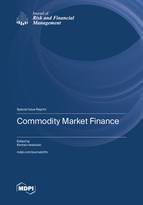Commodity Market Finance
A special issue of Journal of Risk and Financial Management (ISSN 1911-8074). This special issue belongs to the section "Financial Markets".
Deadline for manuscript submissions: closed (1 June 2023) | Viewed by 76007
Special Issue Editor
Special Issue Information
Dear Colleagues,
As an active researcher in the field of commodity market finance, we would like to draw your attention to the Special Issue of the Journal of Risk and Financial Management (JRFM) on "Commodity Market Finance” that we are guest editing.
Commodity markets have evolved substantially since the early 2000s and have become more financialized. The recent cold war between the U.S.A. and China, the outbreak of COVID-19, and Russia's invasion of Ukraine have caused resource prices to soar, leading to greater volatility in the commodity markets. The volatility of the commodity markets has increased, and at the same time, financial markets such as the stock market, bond market, and foreign exchange market have become unstable. This has increased the linkage between the commodity markets and the financial markets and has led to a great deal of attention being paid to the commodity markets by governments, companies, and investors.
This Special Issue aims to cover recent developments in research on commodity market finance. We seek contributions in empirical research on commodity markets including, but not limited to, derivative pricing and valuation, risk and volatility, microstructure and efficiency, forecasting, market interrelationships, financialization, and interactions between commodity markets and the real economy. The markets of interest include those for industrial and precious metals, energy, agricultural products and livestock, and other commodities such as rubber.
Please check the following website for more information:
If you would like to contribute, please submit your manuscript prior to the deadline of 31 December 2022. Please contact us if you would like to submit a manuscript but are unable to meet the deadline. Instructions for authors are available on the journal website (https://www.mdpi.com/journal/jrfm/instructions). Submitted papers should not have been published previously, nor be under consideration for publication elsewhere.
Prof. Dr. Kentaro Iwatsubo
Guest Editor
Manuscript Submission Information
Manuscripts should be submitted online at www.mdpi.com by registering and logging in to this website. Once you are registered, click here to go to the submission form. Manuscripts can be submitted until the deadline. All submissions that pass pre-check are peer-reviewed. Accepted papers will be published continuously in the journal (as soon as accepted) and will be listed together on the special issue website. Research articles, review articles as well as short communications are invited. For planned papers, a title and short abstract (about 100 words) can be sent to the Editorial Office for announcement on this website.
Submitted manuscripts should not have been published previously, nor be under consideration for publication elsewhere (except conference proceedings papers). All manuscripts are thoroughly refereed through a single-blind peer-review process. A guide for authors and other relevant information for submission of manuscripts is available on the Instructions for Authors page. Journal of Risk and Financial Management is an international peer-reviewed open access monthly journal published by MDPI.
Please visit the Instructions for Authors page before submitting a manuscript. The Article Processing Charge (APC) for publication in this open access journal is 1400 CHF (Swiss Francs). Submitted papers should be well formatted and use good English. Authors may use MDPI's English editing service prior to publication or during author revisions.
Keywords
- commodities
- financialization
- volatility
- COVID-19
- energy
- metals





